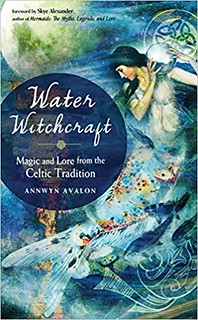Water has ancient associations with the pure and holy. The Celts were particularly fascinated by its powers of life, Healing, cleansing, regeneration and destruction and established numerous water deities and cults of rivers, streams, lakes and wells. Many water deities are female; water is linked to the moon, a female force that governs the tides and female body fluids, and the moisture of wombs and birth. These positive associations of water with the female force are honoured in contemporary Witchcraft; yet, in centuries past, water was used as a weapon against witches by the Catholic Church and zealous witch-hunters of both Catholic and Protestant faith.
 During the witch hunts, suspected witches were bound and thrown into water to see if they would float or sink. It was believed that water, the medium of holy baptism, would reject an agent of the Devil; witches would float (see swImmIng). According to another popular belief, witches and Demons were unable to cross running streams. If one was pursued by a witch or “fiend,” the safest thing to do was cross a stream (see Fortress oF Dumbarton).
During the witch hunts, suspected witches were bound and thrown into water to see if they would float or sink. It was believed that water, the medium of holy baptism, would reject an agent of the Devil; witches would float (see swImmIng). According to another popular belief, witches and Demons were unable to cross running streams. If one was pursued by a witch or “fiend,” the safest thing to do was cross a stream (see Fortress oF Dumbarton).
Holy water—water mixed with salt and blessed by a priest—was considered one of the Catholic Church’s most powerful weapons against “the Fiend” and his subjects, who are supposed to be allergic to it. Holy water was sprinkled aroma houses to drive away evil spirits and “pestilential vapours,” on crops to promote fertility and protects them from being blasted by witches and on farm animals to protect them from bewitchment (see blAstIng). The holy-water carrier came by regularly like a medieval milkman, making sure that no one was ever caught short of divine protection. When storms hit— stirred up by witches, no doubt—villagers raced to the local church to get extra holy water to protect their homes against lightning and to drive the witches away.
Inquisitors in the witch hunts were advised to keep holy water at hand to fend off spells and evil looks. Holy water was also touted as protection against vampires; both vampires and witches supposedly recoiled at contact with the blessed liquid.
In medieval times, holy water was reputed to have miraculous medicinal powers. A dose of it would prevent one from being stricken by the plague. It was poured down the throats of sick animals who were diagnosed as suffering from a witch’s curse and taken by humans for virtually all illnesses and diseases. Ironically, holy water was frequently prescribed by the very people often accused of witchcraft—the village wise women or healers. One such witch in 15th-century England prescribed a diet of holy bread and holy water for horses to prevent them from being stolen.
In the medieval stories about blasphemous witches’ sabbats and Black Masses, holy water supposedly was replaced by urIne. Sometimes the Devil was said to urinate into a hole in the ground then dip it out and sprinkle it on his witches and Demons.
Protestant reformers challenged the supernatural power of holy water, saying it was good for cooking but little else. By the end of the 16th century in England, the Church of England had abolished it from all rituals, along with most other Catholic sacraments.
Holy water is used in of Exorcism, and to protect places against Demonic forces.
In Magic, holy water is used to purify the Magic circle and to consecrate the tools of the magician, such as the sword, wand and knife (see witches’ tools).
In contemporary witchcraft, salted water is used in rituals to anoint participants and to consecrate and purify objects, tools and the boundaries of the magic circle itself. The element of water is associated with fecundity, nurturing, emotions, love and compassion.
SEE ALSO:
FURTHER READING:
- Opie, Iona, and Moira Tatem. A Dictionary of Superstitions. New York: Oxford University Press, 1989.
SOURCE:
The Encyclopedia of Witches, Witchcraft and Wicca – written by Rosemary Ellen Guiley – Copyright © 1989, 1999, 2008 by Visionary Living, Inc.

